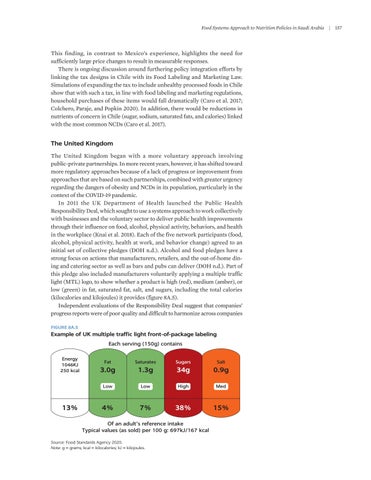Food Systems Approach to Nutrition Policies in Saudi Arabia
This finding, in contrast to Mexico’s experience, highlights the need for sufficiently large price changes to result in measurable responses. There is ongoing discussion around furthering policy integration efforts by linking the tax designs in Chile with its Food Labeling and Marketing Law. Simulations of expanding the tax to include unhealthy processed foods in Chile show that with such a tax, in line with food labeling and marketing regulations, household purchases of these items would fall dramatically (Caro et al. 2017; Colchero, Paraje, and Popkin 2020). In addition, there would be reductions in nutrients of concern in Chile (sugar, sodium, saturated fats, and calories) linked with the most common NCDs (Caro et al. 2017).
The United Kingdom The United Kingdom began with a more voluntary approach involving public-private partnerships. In more recent years, however, it has shifted toward more regulatory approaches because of a lack of progress or improvement from approaches that are based on such partnerships, combined with greater urgency regarding the dangers of obesity and NCDs in its population, particularly in the context of the COVID-19 pandemic. In 2011 the UK Department of Health launched the Public Health Responsibility Deal, which sought to use a systems approach to work collectively with businesses and the voluntary sector to deliver public health improvements through their influence on food, alcohol, physical activity, behaviors, and health in the workplace (Knai et al. 2018). Each of the five network participants (food, alcohol, physical activity, health at work, and behavior change) agreed to an initial set of collective pledges (DOH n.d.). Alcohol and food pledges have a strong focus on actions that manufacturers, retailers, and the out-of-home dining and catering sector as well as bars and pubs can deliver (DOH n.d.). Part of this pledge also included manufacturers voluntarily applying a multiple traffic light (MTL) logo, to show whether a product is high (red), medium (amber), or low (green) in fat, saturated fat, salt, and sugars, including the total calories (kilocalories and kilojoules) it provides (figure 8A.5). Independent evaluations of the Responsibility Deal suggest that companies’ progress reports were of poor quality and difficult to harmonize across companies FIGURE 8A.5
Example of UK multiple traffic light front-of-package labeling Each serving (150g) contains Energy 1046KJ 250 kcal
13%
Fat
Saturates
Sugars
Salt
3.0g
1.3g
34g
0.9g
Low
Low
High
Med
4%
7%
38%
15%
Of an adult’s reference intake Typical values (as sold) per 100 g: 697kJ/167 kcal Source: Food Standards Agency 2020. Note: g = grams; kcal = kilocalories; kJ = kilojoules.
|
157






